 Cusi Inca Yupanqui - Pachacutec The “Alexander the Great of America” According to Garcilaso, Prince Titu Manco Cápac, his father Inca Huiracocha changed his name to "Pachacútec". Acosta calls it "Inga Yupanqui". Others call him "Pachacútec Inca Yupanqui", a name that he would have given himself, after deposing his father and his uncle, Urco. He married Coya Anahuarque and with her he had her heir Inca Yupanqui. He reigned for almost 50 years and had several wives and many other children, "which, being so many, the Indians say were few for children of such a father." For the English historian Sir Clement Markham, Pachacutec is:"The greatest man that the aboriginal race of America has produced."
Cusi Inca Yupanqui - Pachacutec The “Alexander the Great of America” According to Garcilaso, Prince Titu Manco Cápac, his father Inca Huiracocha changed his name to "Pachacútec". Acosta calls it "Inga Yupanqui". Others call him "Pachacútec Inca Yupanqui", a name that he would have given himself, after deposing his father and his uncle, Urco. He married Coya Anahuarque and with her he had her heir Inca Yupanqui. He reigned for almost 50 years and had several wives and many other children, "which, being so many, the Indians say were few for children of such a father." For the English historian Sir Clement Markham, Pachacutec is:"The greatest man that the aboriginal race of America has produced." His first actions of him. During the first years of government, Pachacútec Inca Yupanqui dedicated himself to ordering Cusco, visited his kingdom, subdued the Huancas and was based in Cusco for 3 years in a row. For another three years he paid visits to his Empire. He then enlisted an army of 30 thousand men and left for Chinchasuyu, accompanied by his brother Cápac Yupanqui. From Villca, which was the extreme northwest of his domain, he passed to the curacazgo of Sausa (Xauxa), which had more than 30,000 inhabitants and belonged to the Huanca kingdom. His army, commanded by Cápac Yupanqui, peacefully conquered the Huancas and redistributed them into three curacazgos:Sausa, Marcauillca and Llacsapallanca.
Expansion of Tahuantinsuyu Pachacútec's imperial army continued further north and conquered those of Tarma and Pumpu (in Spanish:Bombón). 150 km to the east of those curacazgos, Cápac Yupanqui subdued the antis, who were jungle tribes. Returning to Pumpu, he continued north. He had war with those of Chucurpu. More than 4,000 soldiers from both sides died; but he subdued them, finally. He followed Ancara and Huaillas. From there he returned to Cusco, where his brother, the Inca, was already waiting for him.
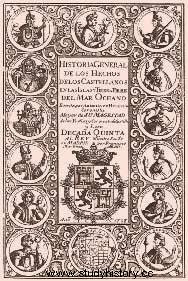 Chronicle published in 1737
Chronicle published in 1737The author is Antonio de Herrera and 13 Incas appear.
Co-reigning Pachacútec dedicated himself to building the public works of his empire for three years, after which he returned to Cusco and after several months of stay in the "Navel of the World", he agreed with his brother and his advisers to undertake another conquering action for the Chinchasuyu. To ensure unequivocal administration and following the custom of his ancestors, Pachacútec also continued with the correinado system, and he did so with Cápac Yupanqui, who was "his second person to him." For this reason, he once again delegated the leadership of the imperial army to his “auqui”, Cápac Yupanqui, whom he had accompanied by his nephew, the crown prince Inca Yupanqui. He had turned 16 years old and had recently passed the huaracu tests (tests of courage).
Northern conquests Pachacútec's formidable troop, which had 50 thousand men of war, left Cusco with all honors to the north and arrived at Chucurpu and from there they peacefully conquered the chiefdom of Pincu. From Pincu (in the current department of Junín), the Inca sent messengers to the curacazgos of Huaras, Piscopampa and Cunchucu (in the current Áncash Region) so that they would join his domain. But those rebellious nations got together and replied that they would maintain their independence, "... that the Inca be content with what he had tyrannized, because with religious zeal he had usurped the lordship of as many curacas as he had held." Huaras, Piscopampa and Cunchucu barricaded themselves in their fortresses and in the ravines of their main roads. Cápac Yupanqui separated his army into 4 divisions of 10,000 soldiers each. His intention was to take them out and starve them into submission. He and his nephew Inca Yupanqui, with another part of the army, stayed at a safe distance, always vigilant of events, to help the party that needed it. At the same time, he sent a brother of his so that the nearby curacazgos would help him in supplies double the ordinary ones. The battles were very hard. The armies of the three curacazgos, in competition of courage, resisted the Inca without retreating from their entrenchments and fortresses. The Inca tried a tactic:the women and children that his troops found on the roads or in the fields, after feeding them, giving them gifts and instructing them, they sent them to their husbands or relatives who were in the battlefields. . His goal was to distract and soften them up. The rebels received the tactic as an insult and stiffened their resistance. They stayed that way for 6 months, until, due to illness, death and hunger, they had to surrender to Cápac Yupanqui. The double supply that the Inca requested from the neighboring curacas was useful, because that was the supply that he left to the vanquished, since the crops of that year were lost. He also left the royal officials to him; he chose the trusted curacas; he ordered the works that had to be done and got ready to continue the conquest towards the north.
Huamachucu:royal field Pacahacútec ordered the imperial troops to go further north, to the current territory of the La Libertad Region, where they peacefully conquered the Huamachucu. As the population of that ethnic group was dispersed and the curaca was friendly, he ordered that the scattered hamlets and huts be reduced to villages of streets and neighborhoods, he proclaimed that the only god was the Sun, not others, and that they "throw into the street the painted stones that they had for idols in their houses". For all this, he put his royal officials in each town. Over time, Huamachucu became one of the reserved areas of Tahuantinsuyu, a kind of national park where there were rare animals and unique plants, brought from all over the country; but visited only by the Zapa Inca and his court.
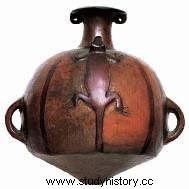 Together with Pachacútec's troops, the
Together with Pachacútec's troops, thespreading in the Andean world the
aribalo, Inca-style huaco.
The people of Cajamarca and their resistance The imperial army went to Cajamarca. Raised the surrender by the emissaries of the Inca, the curacas of the caxamarcas responded that they preferred to die to defend their freedom. Later, the caxamarcas entrenched themselves in the "strong steps", where bitter fights took place, and thousands of soldiers died, on both sides. The same thing happened in open field battles. But the power of the Incas forced the caxamarcas to entrench themselves in fortresses, cliffs and rocks, from where they left to wage a kind of guerrilla warfare (they attacked and ran to hide). That siege lasted about four months, until the Incas' softening tactics paid off and the Cajamarcas surrendered; then, the curaca admitted the domain of the Inca, who decreed peace and support.
Pachacámac
 Because of the treaty between the Incas and Cuismancus
Because of the treaty between the Incas and Cuismancusthe union was achieved, among other things, of
the most powerful gods of the Andes:
Inti and Pachacámac After the rest, given the corresponding provisions to the curacas and royal officials and received a new resupply of the troops, Pachacútec ordered Cápac Yupanqui to go to the central coast of Chinchasuyu, where the kingdom of Cuismancu was and which extended through the valleys from Pachacámac, Rimac, Chancay and Huaman. Upon hearing the Inca's warnings, the king of Cuismancu sent him to say that his gods Pachacámac ("maker and sustainer of the world"), Rímac ("he who speaks") and Mamacocha ("mother-sea"):"... They were superior to the Inti, so it was considered as king as the one from Cozco". As the Incas also recognized Pachacámac as a god, despite not knowing him, because his fame came from before, Cápac Yupanqui reiterated his request for peaceful submission. Cuismancu took several days to give an answer, until peace was agreed upon under the following conditions:1. That the Cuismancu accepted the Sun as their god while the Incas would continue to believe in Pachacámac. 2. That the house of the Virgins of the Sun be built in the temple of Pachacámac to take care that the ceremonial rites are carried out in honor of Inti. 3. That Cuismancu stayed with his kingdom but as part of the empire. This treaty was celebrated with congratulations and, to honor it before the Inca, Cápac Yupanqui went with Cuismancu to Cusco, where Pachacútec had already arrived from Rucana. "After the triumph, the Inca made mercy to Cuismancu and sent him to his land full of favors and honor."
An empire falls After six years, Pachacútec sent an army of 30 thousand men under the command of Inca Yupanqui and six of his generals, to conquer all the lands of the coast, from the Rímac to the height of Cajamarca. When Inca Yupanqui arrived at Rímac, the curacas of Chuquimancu and Cuismancu came out to greet him with joy and reinforced his army with thousands of other soldiers and a large quantity of military supplies. Later, he went to the valley of Huaman (Barranca) and sent word to the king of Chimu that he accept to integrate the Tahuantinsuyu. The Chimu king had his dominions in the valleys of Parmunca, Huallmi, Santa, Huanapu and Chimu; rich and fertile. The answer was that he was waiting for him with "weapons in his hands to die in defense of his country, laws and customs and that he did not want new gods." Inca Yupanqui, then, went to Parmunca, where the opposing army was already waiting for him. Both armies locked in a hard battle, with first results in favor of Chimu. But the Inca Yupanqui received a relief army of 20 thousand soldiers and fiercely charged the tired Chimu troops. The curacas and the nobles of the Chimu kingdom went to their king to ask him to surrender. Chimu Cápac did not want to; but seeing the reality and having received a cordial message from Inca Yupanqui, he gathered his council and the surrender was agreed upon.
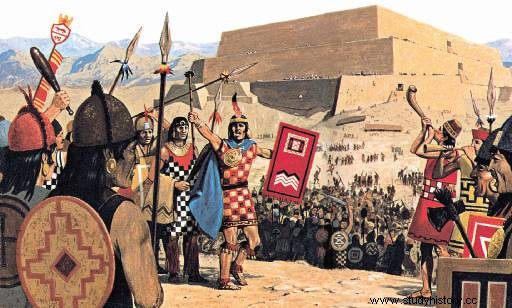 The royal Zapa Inca goes with his army to conquer kingdoms, lordships and curacazgo I redid everything 1. He embellished Cusco, mainly the Coricancha, which was plated with gold sheets and precious stones. 2. He had the royal roads widened and ordered the construction of palaces, temples of the sun, royal inns to house the nobles and supply their army and people in need. 3. He created several yachayhuasis and increased the number of amautas for the education of the nobility. 4. He generalized the use of Quechua as the official language. 5. He regulated that work be compulsory, for which he created sources of work throughout the empire. So many things had to be done in cities and fields that children, adults, old people and invalids also had jobs. Special judges prosecuted laziness and punished the guilty. However, three days a month were dedicated to collective rest and parties. 6. During these festivities, it was arranged that the "catu" or product fairs be held by guamani or provinces, so that artisans and peasants can exchange their products. 7. He ordered that the division of Tahuantinsuyu, through guamanis, be absolutely precise; in such a way that the territorial limits of each of the provinces of the empire were well demarcated. He did the same with the cities. "He made law that any province or city had an established terminus that enclosed in itself the mountains, pastures, forests, rivers and lakes and farmland, which things belonged to that city or province in term and perpetual jurisdiction."
The royal Zapa Inca goes with his army to conquer kingdoms, lordships and curacazgo I redid everything 1. He embellished Cusco, mainly the Coricancha, which was plated with gold sheets and precious stones. 2. He had the royal roads widened and ordered the construction of palaces, temples of the sun, royal inns to house the nobles and supply their army and people in need. 3. He created several yachayhuasis and increased the number of amautas for the education of the nobility. 4. He generalized the use of Quechua as the official language. 5. He regulated that work be compulsory, for which he created sources of work throughout the empire. So many things had to be done in cities and fields that children, adults, old people and invalids also had jobs. Special judges prosecuted laziness and punished the guilty. However, three days a month were dedicated to collective rest and parties. 6. During these festivities, it was arranged that the "catu" or product fairs be held by guamani or provinces, so that artisans and peasants can exchange their products. 7. He ordered that the division of Tahuantinsuyu, through guamanis, be absolutely precise; in such a way that the territorial limits of each of the provinces of the empire were well demarcated. He did the same with the cities. "He made law that any province or city had an established terminus that enclosed in itself the mountains, pastures, forests, rivers and lakes and farmland, which things belonged to that city or province in term and perpetual jurisdiction."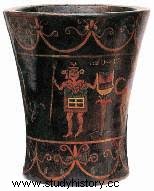 Inca ceremonial vessel with warrior print. Regarding land ownership, the wise decisions made by Pachacútec Inca Yupanqui were the following:1. In all the territorial constituencies he respected the lands of the curacas. 2. The other lands (which had ancestrally belonged to the village communities or those that were products of the expansion of cultivation areas, thanks to irrigation and terraces), he divided into tupus, and handed over to the runas, for each family. .. "And that no governor or curaca would dare to reduce them, divide or apply any part for himself or for another,... indicating their parts for the royal income (note:"Inca lands) and for the sun (note :"lands of the sol")”. Inca Garcilaso de la Vega says:"From here it turns out to be false what many falsely affirm:that the Indians did not have the right to property in their estates and lands, not understanding that that division was made not by account or reason of the possessions but by the common and particular work that they had to put in tilling them". 3. In the great circumscriptions, he approved the inheritances of the states and lordships according to the ancient custom of each province or kingdom.
Inca ceremonial vessel with warrior print. Regarding land ownership, the wise decisions made by Pachacútec Inca Yupanqui were the following:1. In all the territorial constituencies he respected the lands of the curacas. 2. The other lands (which had ancestrally belonged to the village communities or those that were products of the expansion of cultivation areas, thanks to irrigation and terraces), he divided into tupus, and handed over to the runas, for each family. .. "And that no governor or curaca would dare to reduce them, divide or apply any part for himself or for another,... indicating their parts for the royal income (note:"Inca lands) and for the sun (note :"lands of the sol")”. Inca Garcilaso de la Vega says:"From here it turns out to be false what many falsely affirm:that the Indians did not have the right to property in their estates and lands, not understanding that that division was made not by account or reason of the possessions but by the common and particular work that they had to put in tilling them". 3. In the great circumscriptions, he approved the inheritances of the states and lordships according to the ancient custom of each province or kingdom. Family and other rules The main social dispositions that Pachacútec made were the following:a) All children owed obedience and service to their parents until they were 25 years old. b) In case of not having practiced the servinacuy, no one would marry without parental permission. c) If they have done the servinacuy, and if it is successful, they could legalize their marriage with parental approval and legitimizing their children. As it says Blas Valera , Pachacútec Inca Yupanqui imposed order and tranquility in Tahuantinsuyu, through the following laws:a). "When the subjects and their captains and curacas obey the king in good spirits, then the kingdom enjoys all peace and quiet." b) . "He who kills his fellow man must die. For this reason, the ancient kings, our progenitors, instituted that any murderer be punished with violent death. And we confirm it again." c). "In no way should thieves be allowed. Who, being able to earn property with honest work and possess it with good rights, want more to have it by stealing or robbing. For which it is very just that he who is a thief be hanged." d). "When the subjects obey what they can, without any contradiction, the kings and governors must use liberality and clemency with them. More otherwise, rigor and justice, but always with prudence." e). "Judges who secretly receive gifts from merchants and litigators should be considered thieves and punished with death, as such."
Testament and death “Son, you see the many great nations that I leave you and you know how much work they have cost me. Let no one raise his eyes against you who lives, even if they are your brothers. I leave these relatives of ours for parents, so that they can advise you. Look out for them and they serve you. When I am dead, you will cure my body and put it in my houses in Patallacta. You will make my bundle of gold in the house of the Sun and in all the provinces subject to me the solemn sacrifices, and finally the festival of Purucaya, so that I go to rest with my father the Sun”. "Pachacútec expired in full imperial apogee. His mummy was placed in Tococache (San Blas/Cusco), in the temple dedicated to Thunder, which he had built [...] He breathed his last breath very old, completely grey, despite the fact that the Andean runes do not turn gray easily. The death of the creator of the Inca empire must have occurred in 1471, but he left it well organized, legislated and administered with provisions that lasted until 1533 and subsequent decades, he planned everything and left it ready for his children and other descendants to take the empire to his maximum splendor. The other sovereigns would do nothing but follow his guidelines. There is no doubt that he was a brilliant man. He encompassed and dominated all activities. He was the most distinguished brain that pre-Columbian America has produced, only comparable to Alejand ro Magno, another distinguished conqueror and creator of an extraordinary empire in the Old World. The territory that he bequeathed was the base of the Peruvian viceroyalty and the current republic of Peru" (Waldemar Espinoza Soriano. Los Incas. Pp. 91-92).
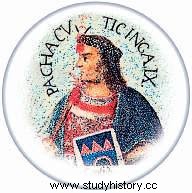 Pachacútec according to a portrait found
Pachacútec according to a portrait foundin the convent of Copacabana
(Bolivia) Source:Julio Villanueva Sotomayor Biography "Pachacutec Inca Yupanqui"
